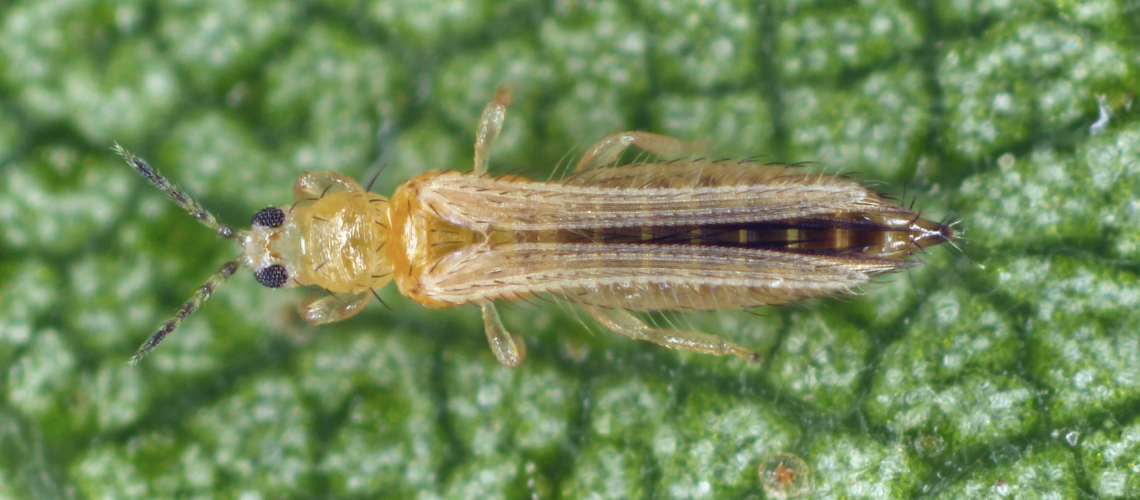Enhancing pesticide efficacy through sugar-based feeding stimulants
By Allan Huysamen, Business Development Manager – Adjuvants, Agri Technovation and Ernst de Beer, Business Development Manager, Laeveld Agrochem
Introduction
Certain insect pests pose a serious threat to crop production potential and the market- ability of agricultural produce, requiring careful strategies that would ensure their effective control or management below damage and economic threshold levels.
The cost of implementing management strategies for specific insect pests of economic significance, such as the South African citrus thrips (Scirtothrips aurantii Faure) (Thysanop- tera: Thripidae) or “thrips”, could constitute a large portion of the entire crop protection budget. It is therefore of critical importance to ensure the efficacy of applied crop protection products. To this effect, an understanding of the phenology and feeding behaviour of these pests is indispensable for devising effective monitoring and pest management strategies. This article focuses on the intricacies of thrips’ feeding habits, the mechanism of insect feed- ing stimulation through applying sugar-based attractant adjuvants, and also introduces an effective solution – SUGAR RUSH™.
Feeding behaviour
Thrips have a unique feeding strategy characterised by the use of specialised mouthparts that pierce plant cells and extract sap for feeding. The mandible is used to puncture plant cells and a sucking mouthpart (stylet) is used to extract the plant cell contents.(1)
Apart from causing cosmetic damage during this process and thereby negatively impacting crop marketability, thrips can also act as a vector for viral infections through saliva that is injected during feeding to facilitate nutrient extraction.(2) For these reasons, the optimisation of pest control through correct application timing and the use of agrochemical performance-enhancing adjuvants are crucial considerations for producers.
Insect feeding stimulation
Various studies have reported the significance of certain chemicals such as sugars, amino acids and proteins, in that they exhibit either a stimulating or a deterrent effect on feeding. Those that stimulate feeding, (phagostimulants), bind to certain receptors (phagostimulatory cells) during feeding and increase the feeding intensity. These receptors have been found in all studied plant-feeding insects and are expected to be present universally as tools used by insects to discriminate between food sources.(3)
Of these phagostimulant compounds, sugars have been reported to cause significantly more feeding stimulation than other compounds.
Fructose, glucose and sucrose are the major contributors, with the latter being consistently reported to be “one of the most stimulating”.(4)
The role of sugar-based adjuvants Relevant insecticides used for thrips control rely largely on stomach-action, requiring ingestion by the target pest to elicit its effect. The feeding behaviour of the target pest is therefore directly related to the efficacy of the application.
Leveraging the feeding stimulant properties of sugars co-applied with certain insecticides in bait spray applications, can significantly
increase the ingestion of these products and therefore result in a more rapid and comprehensive effect. Conversely, poor feeding activity by the target pest can result in insufficient active ingredient uptake and therefore poor control.
Certain crop protection products recommend the addition of white cane sugar to tank mixtures for bait spray applications to take advantage of the feeding stimulant effect.
However, conventional white cane sugar presents various challenges, including the following:
- Single-sugar composition
The single-sugar (sucrose) composition of cane sugar is limiting as it does not take advantage of the phagostimulant properties of other sugar compounds.
- Susceptibility to theft
White cane sugar is regarded as foodstuff/a domestic grocery item, the risk of theft is higher than for non-domestic items.
- Storage risks
Risks related to the storage of white cane sugar in chemical stores include spillages and damage caused by pests attracted to the sugar.
- Contamination during storage
Storage of white cane sugar within chemical stores poses a health and safety risk due to potential contamination with pesticide residues and subsequent consumption by humans.

SUGAR RUSH™
900 g.L-1 concentration °Brix = 80 (undiluted product) - Multiple-sugar composition - Easy to mix and apply
A solution: Introducing SUGAR RUSH™
SUGAR RUSH™ combines a unique, high- concentration blend of phagostimulant natural sugars, including fructose and sucrose. It serves as a powerful attractant adjuvant and feeding stimulant for use with relevant crop protection products.
The co-application of SUGAR RUSH™ with relevant stomach-action active ingredients improves the efficacy of applications by stimulating an increased feeding intensity in pests and promoting a more rapid intake of stomach-action insecticides for accelerated pest control.
SUGAR RUSH™ mitigates the risks associated with the use and storage of white cane sugar, including risks related to theft, the storage of foodstuff in chemical stores and possible consumption after contamination.
The formulated product also presents specifically as an agricultural input product (and not for domestic use), which removes any ambiguity associated with its use.
Conclusion
Ensuring maximum efficacy of applied crop protection products is an important step in optimising pest-management strategies, together with ensuring the correct timing of applications, monitoring and the implementation of IPM (integrated pest management). This is particularly important in the case of pests such as thrips, where the adverse impact on yield and profitability can be devastating.
The use of SUGAR RUSH™ as a feeding stimulant, with relevant stomach-action products, can significantly improve pest control and positively impact the efficacy of these applications which constitute a large portion of the crop protection budget.
References:
- A. Mound, Bull. Entomol. Res., 1971, 60, 547–548.
- Kindt, N.N. Joosten, D. Peters, W.F. Tjallingii, J. Insect Physiol., 2003, 49, 183-191.
- F. Chapman, Annu. Rev. Entomol., 2003, 48, 455–484.
- R. Hervé, R. Delourme, A. Gravot, N. Marnet, S. Berardocco, A. M. Cortesero, J. Chem. Ecol., 2014, 40, 1220–1231.





